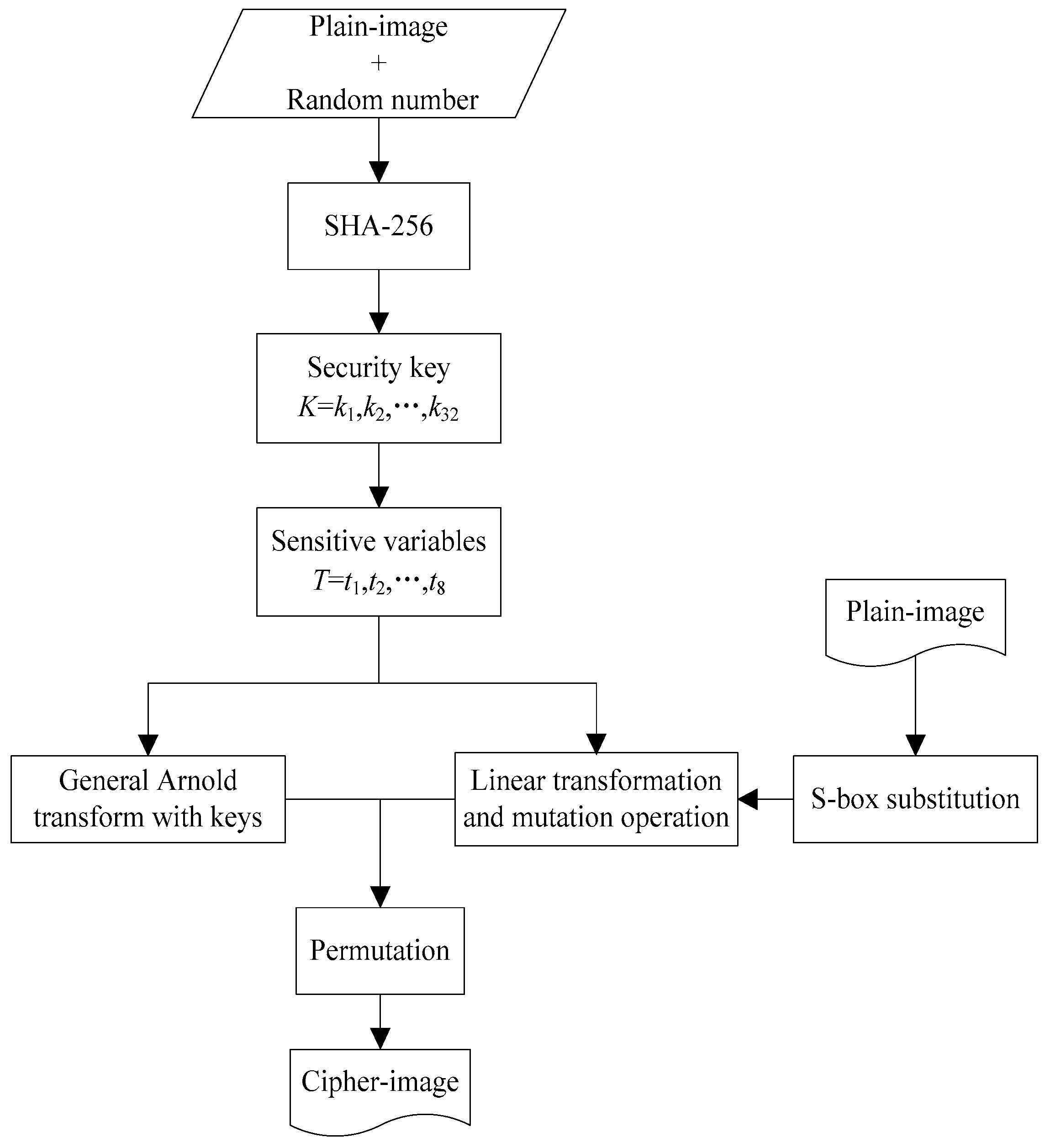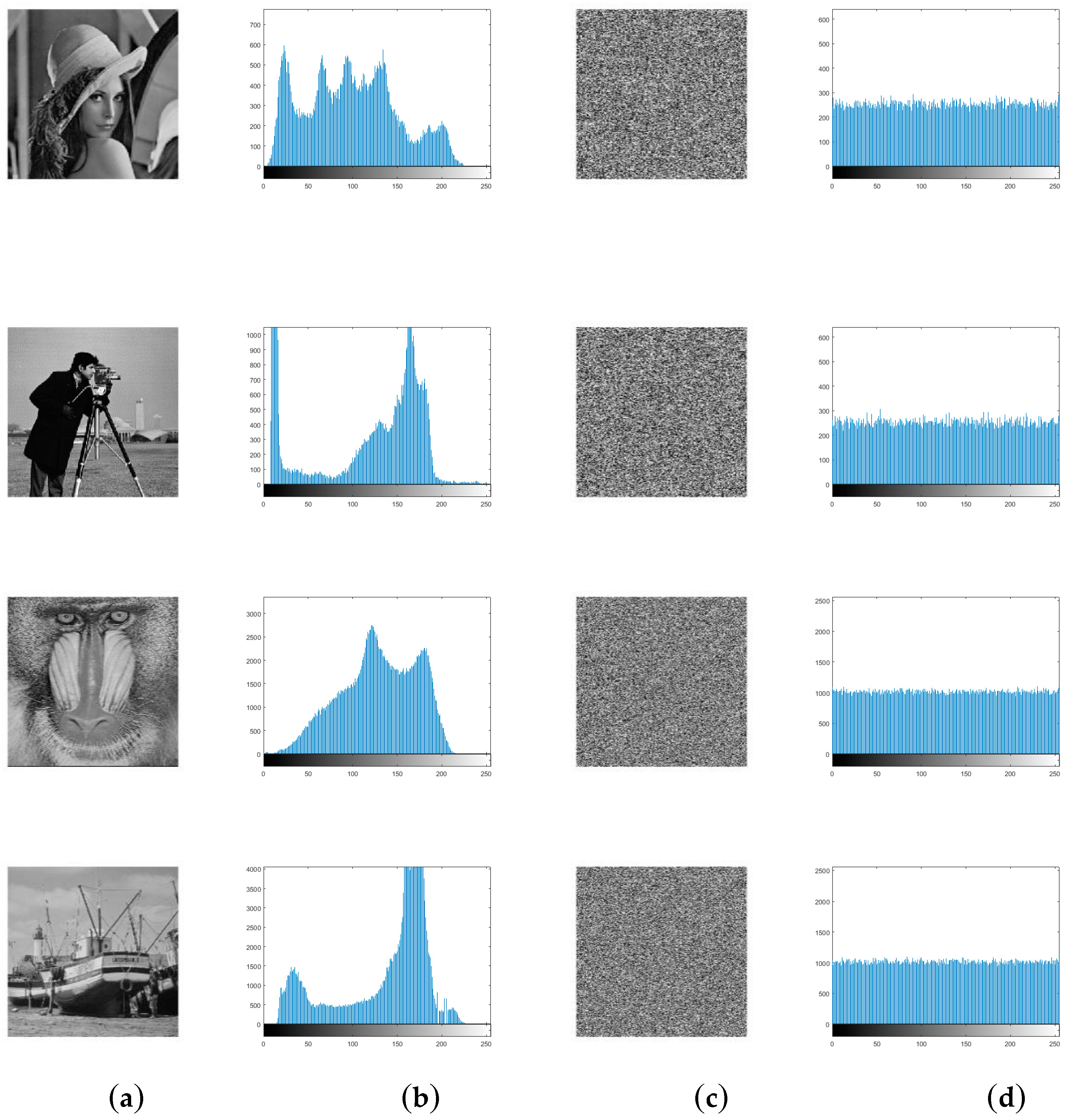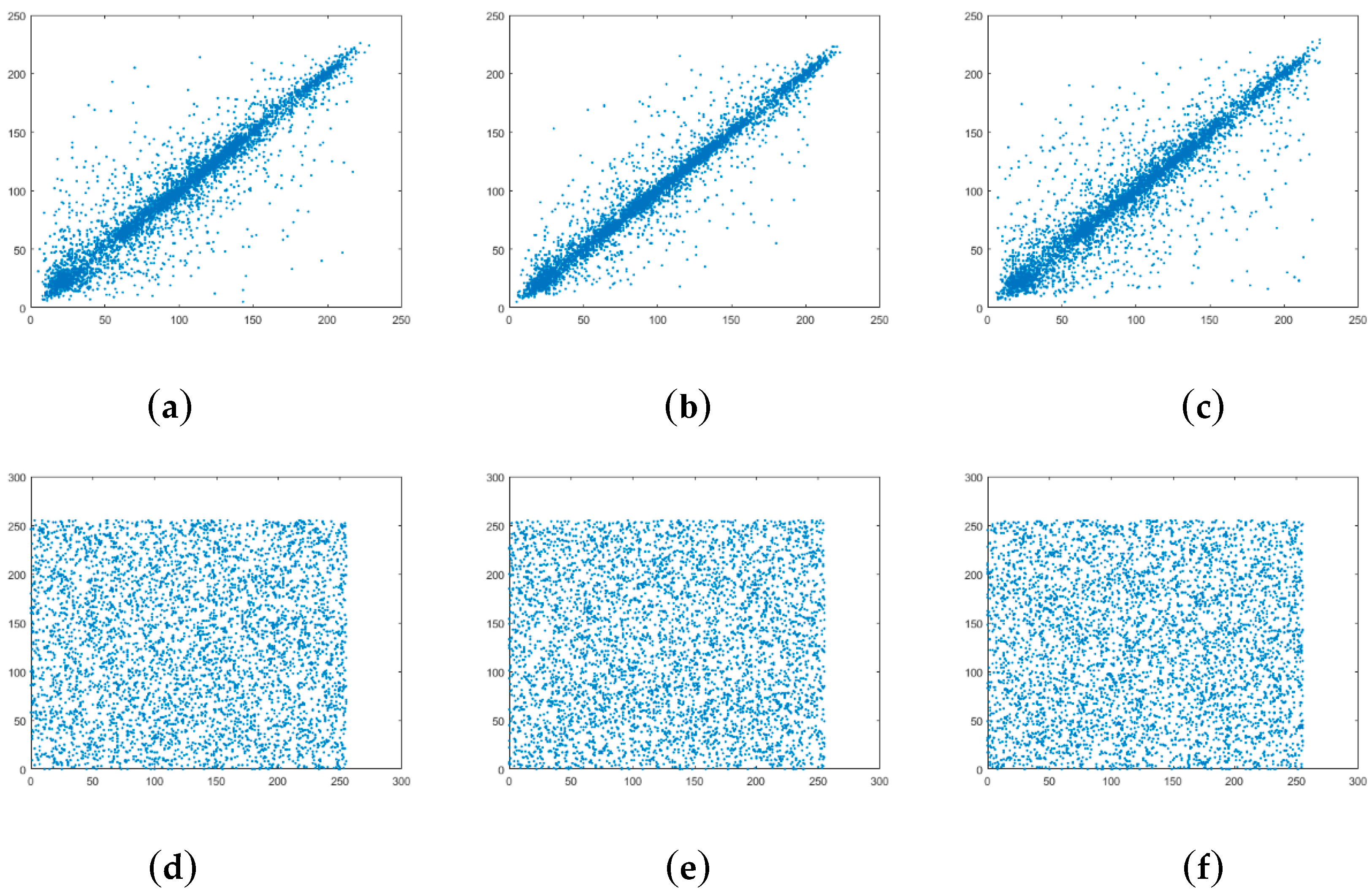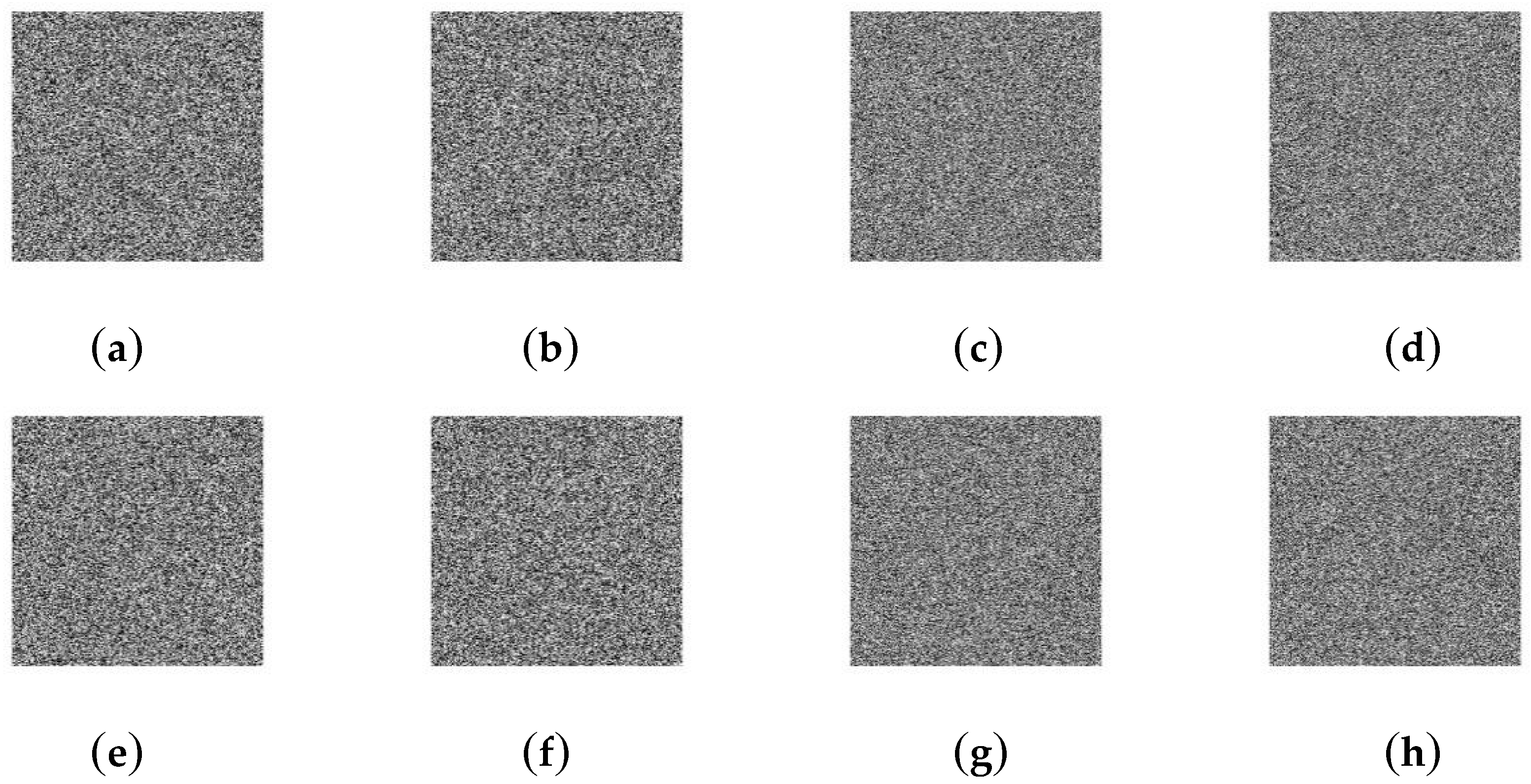Quantum Image Encryption Scheme Using Arnold Transform and S-box Scrambling
Abstract
:1. Introduction
- (1)
- We design an efficient and lossless image encryption scheme based on novel architecture, which combines permutation with scrambling. Before the permutation of the Arnold transform, the gray-level encryption has executed by means of S-box substitution and linear transformation with quantum chaos sequence. The architecture combines permutation and gray-level encryption and eliminates the periodicity brought by the Arnold transform.
- (2)
- Traditional key generator based on SHA-256 hash gets a fixed value if the plain-image has no change. We take a string of random numbers and the plain-image into SHA-256 hash and get a flexible security key due to change in random numbers. This scheme preserves the advantages of SHA-256 hash and provides a flexible security key.
- (3)
- The algebraic transformation Equation (7) is designed to get some extremely sensitive variables to session keys for resistance against key sensitivity attacks. A slight alteration of security key can cause unpredictable changes in the initial parameters and conditions.
- (4)
- Mutation operation based on quantum random selection is presented to modify the value of diffused pixels for high randomness. The results prove that it can decrease the relationship of adjacent pixels in multiple directions.
2. Preliminary
2.1. General Arnold Transform with Keys
2.2. Quantum Chaotic Map
2.3. Mutation Operation
3. Cryptosystem
3.1. Key Generator
3.2. Encryption Approach
3.3. Decryption Approach
4. Security Analysis
4.1. Histogram Analysis
4.2. Correlation Coefficients
4.3. Information Entropy
4.4. Sensitivity Analysis
4.4.1. Differential Analysis
4.4.2. Security Key Analysis
4.5. Mean Squared Error
4.6. Root Mean Squared Error
4.7. Mean Absolute Error
4.8. Key Space Analysis
4.9. Running Performance
5. Conclusions
Author Contributions
Funding
Conflicts of Interest
References
- Zhang, Y. Test and verification of AES used for image encryption. 3D Res. 2018, 9, 37–51. [Google Scholar] [CrossRef]
- Mossa, E. Security enhancement for AES encrypted speech in communications. Int. J. Speech Technol. 2017, 20, 1–7. [Google Scholar] [CrossRef]
- Ueno, R.; Homma, N.; Sugawara, Y. Formal approach for verifying Galois field arithmetic circuits of higher degrees. IEEE Trans. Comput. 2017, 66, 431–442. [Google Scholar] [CrossRef]
- Zeng, X.Q.; Chen, Y.N.; Xu, B. A color image encryption algorithm based on improved DES. Appl. Mech. Mater. 2015, 743, 379–384. [Google Scholar]
- Tang, H.; Sun, Q.T.; Yang, X.; Long, K. A network coding and DES based dynamic encryption scheme for moving target defense. IEEE Access 2018, 6, 26059–26068. [Google Scholar] [CrossRef]
- Wang, D.; Wu, L.; Zhang, X. Key-leakage hardware Trojan with super concealment based on the fault injection for block cipher of SM4. Electron. Lett. 2018, 54, 810–812. [Google Scholar] [CrossRef]
- Kang, H.C.; Hong, D.; Sung, J.; Hong, S. Known-key attack on SM4 block cipher. IEICE Transactions on Fundamentals of Electronics. Commun. Comput. Sci. 2017, 100, 2985–2990. [Google Scholar]
- Du, Z.B.; Wu, Z.; Wang, M.; Rao, J.-T. Improved chosen-plaintext power analysis attack against SM4 at the round-output. J. Commun. 2015, 36, 85–91. [Google Scholar]
- Hariyanto, E.; Rahim, R. Arnold’s cat map algorithm in digital image encryption. Int. J. Sci. Res. 2016, 5, 6–391. [Google Scholar]
- Farwa, S.; Muhammad, N.; Shah, T. A novel image encryption based on algebraic S-box and Arnold transform. 3D Res. 2017, 8, 26. [Google Scholar] [CrossRef]
- Singh, P.; Yadav, A.K.; Singh, K. Phase image encryption in the fractional Hartley domain using Arnold transform and singular value decomposition. Opt. Lasers Eng. 2017, 91, 187–195. [Google Scholar] [CrossRef]
- Liu, Z.; Gong, M.; Dou, Y. Double image encryption by using Arnold transform and discrete fractional angular transform. Opt. Lasers Eng. 2012, 50, 248–255. [Google Scholar] [CrossRef]
- Zhou, N.R.; Hua, T.X.; Gong, L.H. Quantum image encryption based on generalized Arnold transform and double random-phase encoding. Quantum Inf. Process. 2015, 14, 1193–1213. [Google Scholar] [CrossRef]
- Noshadian, S.; Ebrahimzade, A.; Kazemitabar, S.J. Optimizing chaos based image encryption. Multimedia Tools Appl. 2018, 3, 1–22. [Google Scholar] [CrossRef]
- Luo, Y.; Zhou, R.; Liu, J. A parallel image encryption algorithm based on the piecewise linear chaotic map and hyper-chaotic map. Nonlinear Dyn. 2018, 93, 1165–1181. [Google Scholar] [CrossRef]
- Borislav, S.; Krasimir, K. Image encryption using Chebyshev map and rotation equation. Entropy 2015, 17, 2117–2139. [Google Scholar]
- Wang, X.; Zhang, H.L. A novel image encryption algorithm based on genetic recombination and hyper-chaotic systems. Nonlinear Dyn. 2016, 83, 333–346. [Google Scholar] [CrossRef]
- Lambic, D. Security analysis and improvement of the pseudo-random number generator based on quantum chaotic map. Nonlinear Dyn. 2018, 6, 1–10. [Google Scholar] [CrossRef]
- Gong, L.H.; He, X.T.; Cheng, S. Quantum image encryption algorithm based on quantum image XOR operations. Int. J. Theor. Phys. 2016, 55, 3234–3250. [Google Scholar] [CrossRef]
- Seyedzadeh, S.M.; Norouzi, B.; Mosavi, M.R. A novel color image encryption algorithm based on spatial permutation and quantum chaotic map. Nonlinear Dyn. 2015, 81, 511–529. [Google Scholar] [CrossRef]
- Liu, H.; Jin, C. A novel color image encryption algorithm based on quantum chaos sequence. 3D Res. 2017, 8, 4–16. [Google Scholar] [CrossRef]
- Akhshani, A.; Akhavan, A.; Mobaraki, A. Pseudo random number generator based on quantum chaotic map. Commun. Nonlinear Sci. Numer. Simul. 2014, 19, 101–111. [Google Scholar] [CrossRef]
- Michail, H.; Kakarountas, A.; Milidonis, A. Efficient FPGA implementation of novel cryptographic hashing core. Comput. Lett. 2006, 2, 21–27. [Google Scholar] [CrossRef]
- Rehman, A.-U.; Ullah, S.; Liao, X.; Kulsoom, A. A modified (Dual) fusion technique for image encryption using SHA-256 hash and multiple chaotic maps. Multimedia Tools Appl. 2016, 75, 1–26. [Google Scholar]
- Chai, X.; Gan, Z.; Yang, K. An image encryption algorithm based on the memristive hyperchaotic system, cellular automata and DNA sequence operations. Signal Process. Image Commun. 2017, 52, 6–19. [Google Scholar] [CrossRef]
- Chai, X. An image encryption algorithm based on bit level Brownian motion and new chaotic systems. Multimedia Tools Appl. 2017, 76, 1159–1175. [Google Scholar] [CrossRef]
- Kwon, Y.; Kim, D.; Son, Y. Be selfish and avoid dilemmas: Fork after withholding (FAW) attacks on bitcoin. In Proceedings of the ACM Conference on Computer and Communications Security (CCS), Dallas, TX, USA, 30 October 2017; pp. 195–209. [Google Scholar]
- Upadhyay, G.; Nene, M.J. One time pad generation using quantum superposition states. In Proceedings of the IEEE International Conference on Recent Trends in Electronics, Information and Communication Technology, Bangalore, India, 20–21 May 2016; pp. 1882–1886. [Google Scholar]
- Ferdush, J.; Begum, M.; Mahmood, A. A new image encryption technique combining the idea of one time pad with RGB value. Int. J. Comput. Appl. 2017, 178, 12–15. [Google Scholar] [CrossRef]
- Abdullah, S.; Ayub, S.; Hussain, I. Analyses of S-boxes based on interval valued intuitionistic fuzzy sets and image encryption. Int. J. Comput. Intell. Syst. 2017, 10, 851–865. [Google Scholar] [CrossRef]
- Rehman, I.; Razzaque, A.; Shah, T. A novel approach to analyze S-boxes in image encryption using fuzzy soft set aggregation operator. J. Multiple-Valued Logic Soft Comput. 2017, 28, 495–510. [Google Scholar]
- Friedrich, T.; Kotzing, T.; Krejca, M.S. The compact genetic algorithm is efficient under extreme gaussian noise. IEEE Trans. Evolut. Comput. 2017, 21, 477–490. [Google Scholar] [CrossRef]
- Metawa, N.; Hassan, M.K.; Elhoseny, M. Genetic algorithm based model for optimizing bank lending decisions. Expert Syst. Appl. 2017, 80, 75–82. [Google Scholar] [CrossRef]
- Fips, N. Announcing the advanced encryption standard (AES). Fed. Inf. Process. Stand. Publ. 2001, 29, 2200–2203. [Google Scholar]
- Chai, X.; Fu, X.; Gan, Z.; Lu, Y.; Chen, Y. A color image cryptosystem based on dynamic DNA encryption and chaos. Signal Process. 2019, 155, 44–62. [Google Scholar] [CrossRef]
- Khan, M.; Shah, T.; Batool, S.I. Construction of S-box based on chaotic Boolean functions and its application in image encryption. Neural Comput. Appl. 2016, 27, 677–685. [Google Scholar] [CrossRef]
- Khan, M.; Shah, T. A Novel Statistical Analysis of Chaotic S-box in Image Encryption. 3D Res. 2014, 5, 1–8. [Google Scholar] [CrossRef]
- Ye, G.; Pan, C.; Huang, X. An efficient pixel-level chaotic image encryption algorithm. Nonlinear Dyn. 2018, 1–12, 745–756. [Google Scholar] [CrossRef]
- Patro, K.; Acharya, B. Secure multi-level permutation operation based multiple colour image encryption. J. Inf. Secur. Appl. 2018, 40, 111–133. [Google Scholar] [CrossRef]
- Kulsoom, A.; Xiao, D.; Rehman, A.-U.; Abbas, S.A. An efficient and noise resistive selective image encryption scheme for gray images based on chaotic maps and DNA complementary rules. Multimedia Tools Appl. 2016, 75, 1–23. [Google Scholar] [CrossRef]




| Images | Lena | Cameraman | Baboon | Boats |
|---|---|---|---|---|
| Plain-image | 30665.70 | 110973.30 | 750395.63 | 1583351.60 |
| Cipher-image | 256.54 | 251.85 | 975.09 | 931.88 |
| Scan Direction | Lena | Cameraman | Baboon | Boats | ||||
|---|---|---|---|---|---|---|---|---|
| Plain | Cipher | Plain | Cipher | Plain | Cipher | Plain | Cipher | |
| Horizontal | 0.938596 | 0.000455 | 0.926835 | 0.000282 | 0.839511 | 0.001276 | 0.808009 | 0.000560 |
| Vertical | 0.966742 | 0.002175 | 0.958801 | 0.016975 | 0.724123 | 0.021980 | 0.961392 | 0.002198 |
| Diagonal | 0.916518 | 0.003801 | 0.912749 | 0.011328 | 0.684117 | 0.010744 | 0.833386 | 0.010743 |
| Images | Lena | Cameraman | Baboon | Boats |
|---|---|---|---|---|
| Plain-image | 7.568285 | 7.009716 | 7.357949 | 7.123758 |
| Cipher-image | 7.997860 | 7.997538 | 7.999354 | 7.999332 |
| Algorithm | Information Entropy |
|---|---|
| Proposed | 7.9979 |
| [21] | 7.9973 |
| [24] | 7.9973 |
| [36] | 7.9972 |
| Images | NPCR | UACI |
|---|---|---|
| Lena | 0.996119 | 0.334033 |
| Cameraman | 0.996017 | 0.334313 |
| Baboon | 0.996094 | 0.334526 |
| Boats | 0.996017 | 0.334361 |
| Pixels | (1, 1) | (27, 103) | (144, 178) | (201, 224) | (217,105) | (255,255) |
|---|---|---|---|---|---|---|
| NPCR | 0.996383 | 0.996199 | 0.996262 | 0.996093 | 0.996338 | 0.995834 |
| UACI | 0.334751 | 0.333843 | 0.334560 | 0.333072 | 0.334543 | 0.333060 |
| Algorithm | NPCR | UACI |
|---|---|---|
| Proposed | 0.996119 | 0.334033 |
| [20] | 0.996012 | 0.335376 |
| [24] | 0.996074 | 0.309976 |
| [36] | 0.996124 | 0.334591 |
| Images | NPCR | UACI |
|---|---|---|
| Lena | 0.996094 | 0.334603 |
| Cameraman | 0.995804 | 0.336895 |
| Baboon | 0.996036 | 0.334515 |
| Boats | 0.996017 | 0.334361 |
| Images | Lena | Cameraman | Baboon | Boats |
|---|---|---|---|---|
| MSE | 9069.366196 | 9486.689178 | 7247.521557 | 8287.326183 |
| RMSE | 95.233220 | 97.399636 | 85.132377 | 91.034753 |
| MAE | 78.201950 | 79.741455 | 70.969791 | 75.038555 |
© 2019 by the authors. Licensee MDPI, Basel, Switzerland. This article is an open access article distributed under the terms and conditions of the Creative Commons Attribution (CC BY) license (http://creativecommons.org/licenses/by/4.0/).
Share and Cite
Liu, H.; Zhao, B.; Huang, L. Quantum Image Encryption Scheme Using Arnold Transform and S-box Scrambling. Entropy 2019, 21, 343. https://doi.org/10.3390/e21040343
Liu H, Zhao B, Huang L. Quantum Image Encryption Scheme Using Arnold Transform and S-box Scrambling. Entropy. 2019; 21(4):343. https://doi.org/10.3390/e21040343
Chicago/Turabian StyleLiu, Hui, Bo Zhao, and Linquan Huang. 2019. "Quantum Image Encryption Scheme Using Arnold Transform and S-box Scrambling" Entropy 21, no. 4: 343. https://doi.org/10.3390/e21040343
APA StyleLiu, H., Zhao, B., & Huang, L. (2019). Quantum Image Encryption Scheme Using Arnold Transform and S-box Scrambling. Entropy, 21(4), 343. https://doi.org/10.3390/e21040343




